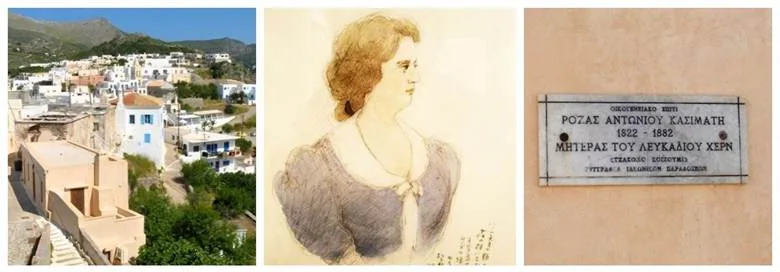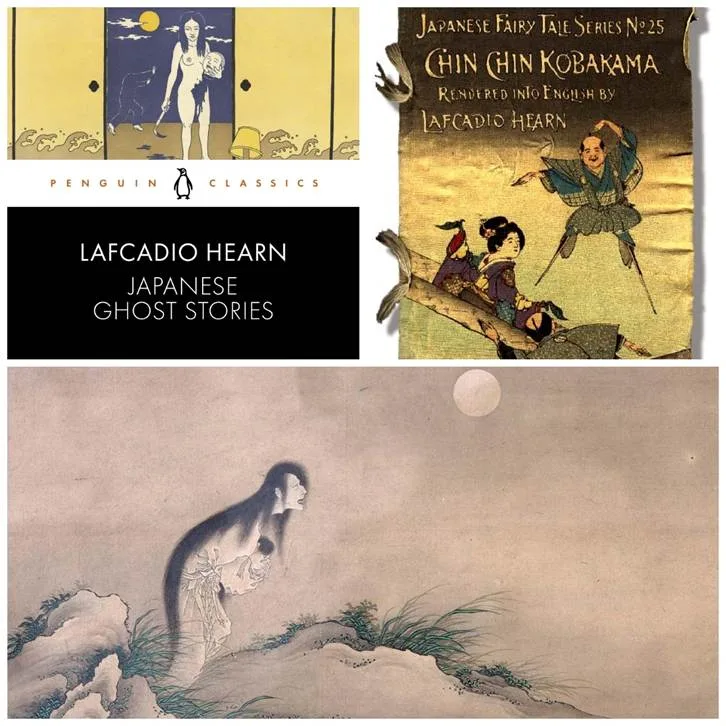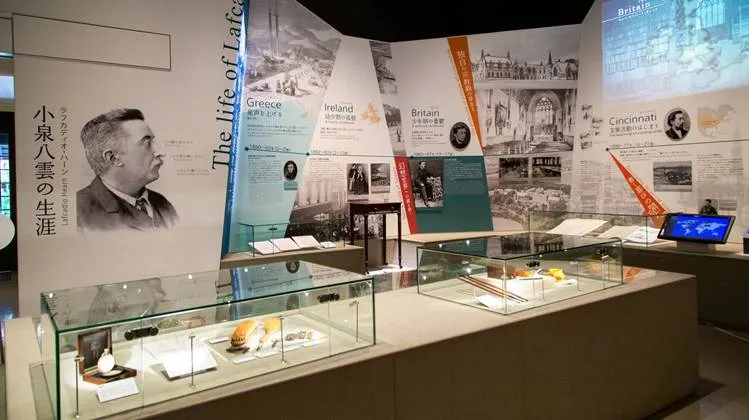By George Vardas*
Patrick Lafcadio Hearn was born on the island of Santa Maura (now more commonly known as Lefkas or Lefkada) in the dark wine Ionian Sea on 27 June 1850.
According to the baptismal records kept on the island, the child was brought to the Greek Orthodox church of Saint Paraskevi by Madam Rosa Cassimati, described as a noble woman originally from Cerigo (Kythera) and the wife of the absent Dr Charles Bush Hearn, an Irish-born Surgeon-Major of the British army. The young child was christened Πατρίκιος Λευκάδιος (Patrick Lafcadio).
From these humble beginnings, the young man (who would go on to abandon the name Paddy in favour of “Lafcadio” by way of reaffirming his maternal and Greek-conceived heritage) evolved into an enigmatic journalist and writer and went on to become the foremost Western interpreter of Japanese folklore, culture and traditions.
Lafcadio Hearn’s life would be a remarkable odyssey from west to east across continents, cultures, and identities.
A Kytherian connection
Major Hearn had been sent to British garrisons in Zante, Ithaca and Corfu during the British Protectorate of the Ionian Islands (1810-1864). From early 1848 he was stationed in the Venetian castle at Hora on the isolated and potentially forbidding island of Cerigo. There he met and fell in love with the strikingly beautiful and spirited Rosa, the daughter of nobility on the island, who lived in a house near the stairs leading to the castle (and which today is maintained as a historical home/museum in tribute to Lafcadio’s embryonic Kytherian lineage).
Rosa eventually fell pregnant to Major Bush and to avoid both family opprobrium and public disapproval, the couple eloped to Lefkas in 1849. Their first child died at an early age. Lafcadio was born the following year.

In July 1852, Lafcadio and his mother moved to Dublin in Ireland. But the young boy had a disrupted and unsettled upbringing after the separation of his parents and he was raised by his paternal great-grand aunt in Ireland. He would never see his mother again after the marriage was annulled and Rosa returned to Kythera and remarried but she remained a constant presence in his thoughts.
Inventing the mystique: Lafcadio Hearn’s enduring influence in America
At the age of 19 years, and after finishing his education in Britain, Lafcadio Hearn emigrated to the United States.
On 2 September 1869 he arrived at the port of New York on the steamship S. S. Cella. The young Hearn declared at entry to the United States that the country he “belonged to” was “Greece.”
The significance of this seemingly innocuous declaration would gradually emerge as he often referred to his southern temperament, once describing himself as “of a meridional race, a Greek” who could more readily identify with the Latin race than with the Anglo-Saxon, thus enabling him to create something different from the stone-grey and somewhat chilly style of latter-day English or American romance.
Hearn moved to Cincinnati and after enduring several years of hardship he found work as a reporter at the Cincinnati Enquirer. Under the byline “Dismal Man” he quickly gained a reputation for his sharp wit, vivid prose, and fascination with the macabre and the unconventional. His early writings were often blood-chilling reports of murders and street crimes that were steeped in gothic horror, reflecting the raw intensity of a writer with a ruthless eye. Although his graphic prose may have shocked many of the Enquirer’s readers he almost singlehandedly managed to rescue the struggling newspaper from the brink of bankruptcy.

In 1877 Lafcadio Hearn moved to Louisiana. In the following year he joined the Daily City Item and soon developed a reputation as a fearless reporter and chronicler of life in New Orleans. In 1881 he was made the literary editor at the Times Democrat.
When Lafcadio arrived in New Orleans, he felt immediately as if he had arrived at home. Before “this divine breath of the ocean” he wrote (drawing on one of his few real Greek reminiscences) … “the Greek sailor, awaking from the vision of winds and waves, may join the three fingers of his right hand, after the manner of the Eastern Church, and cross himself, and sleep again in peace”.
A master storyteller, Hearn was captivated by the vibrant tapestry of New Orleans culture. It is here, amidst the jazzy melodies and Creole whispers, that Hearn’s literary genius found fertile ground, producing works that would immortalize the enduring spirit of New Orleans.
Hearn’s prolific writing for New Orleans newspapers and also in national magazines such as Harper’s Weekly, brought New Orleans to the attention of a wider audience. His focus on the city’s more exotic elements, including its unique blend of French, African, and Creole folklore, voodoo, cuisine, carnival traditions and masked balls, and the colourful characters he encountered in the city’s alleys and lingering shadows, contributed to the image of New Orleans as a mysterious and enchanting city.
He even published a dictionary of Creole proverbs and compiled a collection of Creole recipes, “La Cuisine Créole.”

Mardi Gras and the two worlds of Lafcadio Hearn
To this day Lafcadio Hearn is celebrated as New Orlean’s “Unseen Influencer” such was his impact on the city.

In February 2024 one of the striking themes of the city’s famous annual Mardi Gras carnival was a parade of exotic floats under the banner “The Two Worlds of Lafcadio Hearn: New Orleans and Japan”, celebrating how a young Greek-Irish newspaper reporter rose to prominence in the sultry embrace of New Orleans to promote the vibrant culture and rich tapestry of the famed Crescent City before moving to Japan to reinterpret and reveal Japanese myths, ghost stories and folklore.
As one observer at the Mardi Gras commented, amidst the splendid cacophony of sounds and ‘Lafcadioesque’ imagery, “we love Lafcadio in New Orleans – he got us!”
Japan: A soul’s homecoming
When Lafcadio Hearn left New Orleans in 1887 he initially went to Martinique in the West Indies before finally moving in 1890 to live and write in Japan where he discovered another rich and colourful culture.
He eventually married a Japanese woman of samurai descent, Koizumi Setsu, with whom he had four children. In 1896 he became a Japanese citizen, taking the name Koizumi Yakumo.

Not surprisingly, it was in “ghostly” Japan where Lafcadio Hearn’s literary genius flourished. Between 1896 and 1903, Hearn worked as a professor of English literature at the Imperial University of Tokyo and was drawn to the spiritual elements of Japanese exotic folklore, especially the ghost-story genre known as kaidan.
He proceeded to translate and re-tell traditional Japanese folktales and write other original stories of haunting power.
He authored fourteen books on various aspects of Japanese life and culture. His books, including Kwaidan: Stories and Studies of Strange Things and Glimpses of Unfamiliar Japan and Ghostly Japan, offered a rare and sensitive portrayal of a society in transition and helped open Western eyes to this Asian culture.

He was enchanted by the Japanese civilisation which he saw as being similar to the beautiful vanished world of Greek culture, and compared the natural beauty of Greece and Japan which he likened to the “spirit and the body”. So consistent was this identification that his biographer, Jonathan Cott, observed, “Lafcadio always insisted on his Greek ancestry as determinative of his character, talent, and soul.”
Lafcadio Hearn died in Tokyo in 1904.
On the 150th anniversary of his death, the Japan Times carried a special eulogy to Lafcadio and referred to him as a “story reteller of genius with an instinctive knack for grasping the essence of another culture’s spirituality, legends, rituals and myths”. Hearn was given the ultimate laurel, that of Japan’s ‘gaijin laureate’, the single greatest interpreter in Japanese eyes of their inmost cultural secrets. Lafcadio Hearn had found in Japan a “sanctuary for his imagination”.
The open mind of Lafcadio Hearn: Imagining his mother and homeland

Lafcadio Hearn was a wanderer, a dreamer, a scholar, and a prodigious storyteller blessed with an inquisitive mind. His odyssey of discovery would take him from the sun-drenched isles of Greece to the industrial grit of America, and finally to the temples and legends of Japan.
But the inheritance of his mother’s bloodline also allowed a young Lafcadio Hearn to explore his own Greek “ghost memory”. The imagery of Rosa, the ‘lost’ worlds of Lefkada and Kythera and the feelings of loss of his mother’s loving embrace would continue to haunt him.
In a letter from New York to his younger brother James Daniel in 1890, just before he set out for Japan, Lafcadio said of their mother:
“Whatever there is good in me and, I believe, whatever there is of deeper good in yourself came from that dark race soul of which we know so little. My love of right, my hate of wrong, my admiration for what is beautiful or true, my capacity for faith in man or woman, my sensitiveness to artistic things. I think only of her. And I would rather have her portrait than a fortune.”
2025 marks the 175th anniversary of Lafcadio Hearn’s birth.
To paraphrase Nikolaos Tsamados, the former Ambassador of Greece to Japan, Lafcadio Hearn’s time on this earth, bookended by Greece and Japan, has left an indelible mark on history and his cultural and literary legacy will undoubtedly live on, as we hopefully continue to be able to see the world through the lens of his open mind.
*This is an expanded version of an article published in the Ball Program of the Kytherian Association of Australia on the occasion of its 103rd anniversary. The author is a past president of that association and currently on the committee of the Kytherian World Heritage Fund.
